
focaccia barese
Focaccia Barese is a traditional Italian bread from Bari, the capital of the Apulia region located on the heel of Italy’s boot. You can sometimes find this bread called focaccia pugliese. The dough is formed into a round shape and topped with tomatoes and sometimes black olives. As it bakes, juices from the tomatoes cook down and settle into all the little nooks and crannies. This focaccia is tall, soft, and fluffy, with lots of air pockets and a crunchy edge.
One of the beautiful things about Italian focaccia bread is that there are so many varieties. Depending on where you are in Italy, there is often a regional style. In Genoa, the focaccia is thin and chewy, while in Puglia, it is thick and fluffy.
Many recipes for Focaccia Barese incorporate a mashed potato which helps give this bread softness and moisture. It also uses a mix of regular flour and semolina flour. The semolina adds that slight yellow tint and excellent stretch and elasticity to the dough.
Bari is located on the coast of the Adriatic Sea, so it’s common to eat a big slice of Focaccia Barese at the beach with your toes in the sand. With a dough enriched with potatoes and covered in tomatoes, it feels hearty enough to be an on-the-go lunch or afternoon snack.
Ingredients
Focaccia Dough:
- Flour – manitoba and semolina
- Potato – mashed
- Water
- Yeast
- Extra virgin olive oil
- Salt
Topping:
- Ripe cherry tomatoes
- Dried oregano
- Sea salt
Manitoba flour is a strong flour ground from the North American red wheat. It has a high protein content, making it suitable for leavened breads and developing gluten structure. It’s great for all types of breads including sourdoughs, brioche, or even pizza in some cases. Bread flour can be substituted as it has similar characteristics.
Semolina flour is a type of wheat flour ground from durum wheat. In Italy, “re-milled durum wheat semolina”, semola rimacinata di grano duro, most closely resembles the “semolina flour” found in American grocery stores. It is achieved with an extra step during the milling process creating a fine grain and light color. Ideal for pizzas, focaccia and other leavened products, it has a high gluten content, producing a stretchy and elastic dough. This is why it is commonly used to make pasta, because it helps to hold together the shape of the pasta when it cooks.
Step by Step
First, measure both flours into a large bowl. Stir in the yeast. Instant dry yeast doesn’t need to be activated in water first and can be added straight into the dry ingredients.
Add in half the lukewarm water and the mashed potato. I find it’s easiest to get in there with my hands to smush the ingredients together. Slowly add in remaining water and knead right in the bowl until all the flour is incorporated and a homogeneous dough begins to form. Add in the olive oil and salt. Turn the dough out onto a lightly floured work surface. Knead the dough for 5-10 minutes by folding the dough over itself, using a bench scraper if needed to help move the dough around. Work the dough until a smooth ball is achieved. The dough should be tacky and maybe a little sticky but try not to add more flour. The big bubbles in focaccia require a moist dough, so if you’re having trouble handling the dough, simply dampen your hands with water.
The dough can also be made in an electric stand mixer fitted with the dough hook.
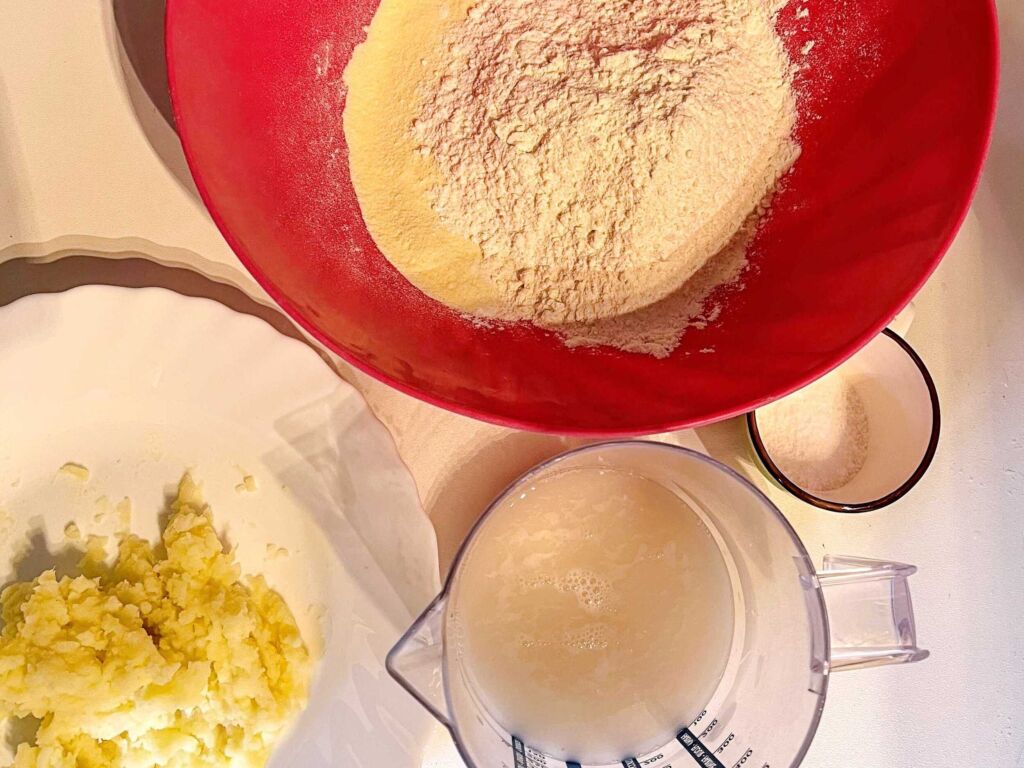
Transfer dough to a lightly oiled bowl and roll the dough ball around so it is entirely coated with a shine of oil. Cover with plastic wrap. Let rest at room temperature for 2 ½ – 3 hours, or until doubled.
Meanwhile, marinate the tomatoes. Add the cherry tomato halves to a small bowl and drizzle with olive oil. Sprinkle with dried oregano, pinch of salt, and black pepper. Stir and let sit at room temperature.
When the dough is ready, gently turn it out into a 30cm pan that you have liberally oiled. More oil is always better with focaccia. Press down gently with your fingertips to stretch out the soft dough. It’s ok if it doesn’t reach all the way to the edges of the pan, it will spread out more after the next rise. If your hands stick to the dough, dampen them with olive oil. Cover and let rest for 30 minutes.
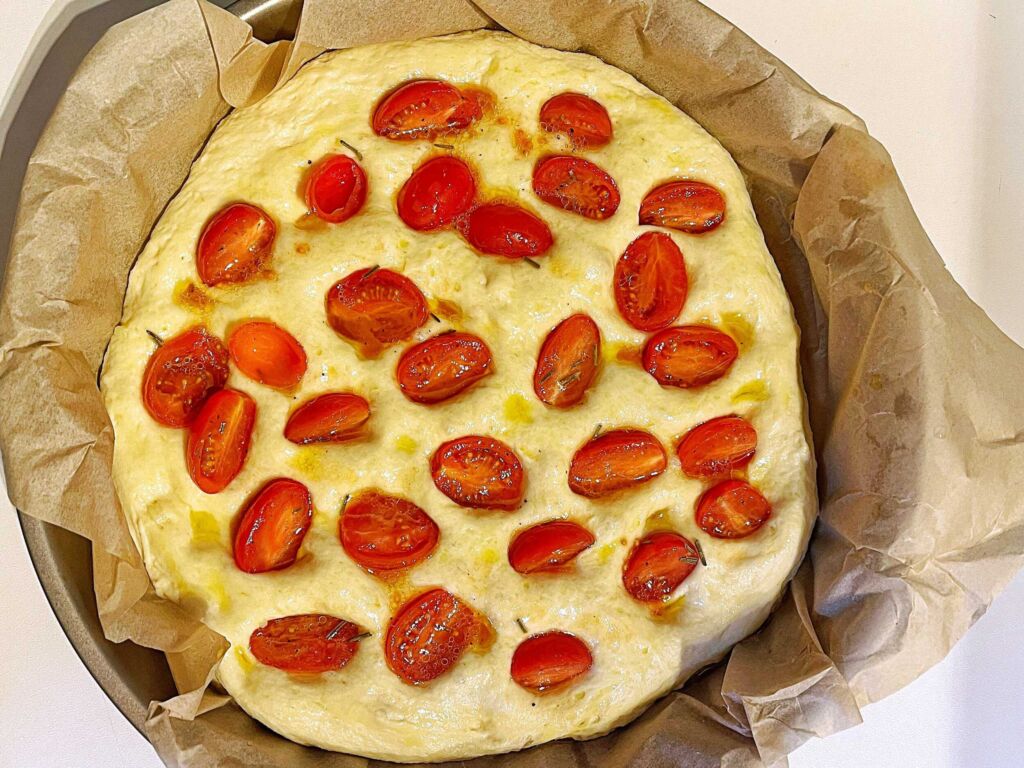
Preheat the oven to 220 °C. Drizzle the top of the focaccia with more olive oil and dimple the top with your fingertips. Press the tomato halves into the dimples and spoon over any juices from the marinade bowl. Sprinkle with more dried oregano and salt.
Bake for 20-25 minutes, or until golden brown.
Remove from oven and serve warm or room temperature.
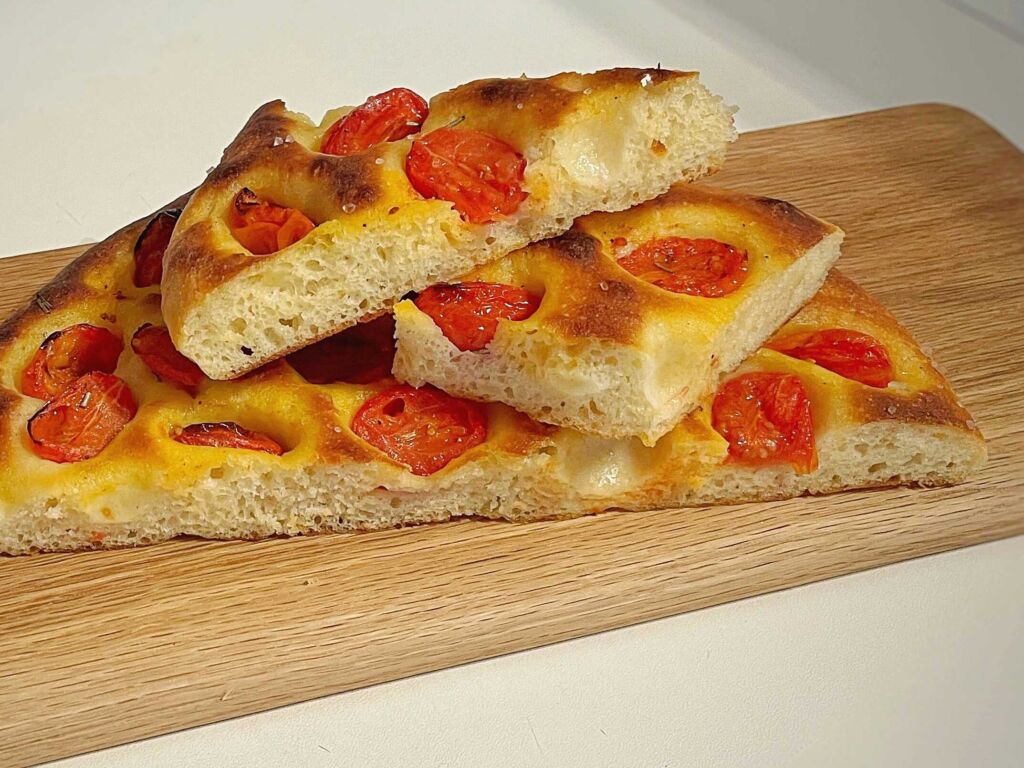
Leftover Focaccia Barese can be wrapped in plastic and stored at room temperature for 3-4 days.
Tips and FAQs
- Bread flour can be substituted in an equal amount for the manitoba flour.
- Try adding pitted black or green olives to the topping!
Focaccia Barese can also be frozen! Once baked and completely cooled, place in a plastic freezer bag and freeze.
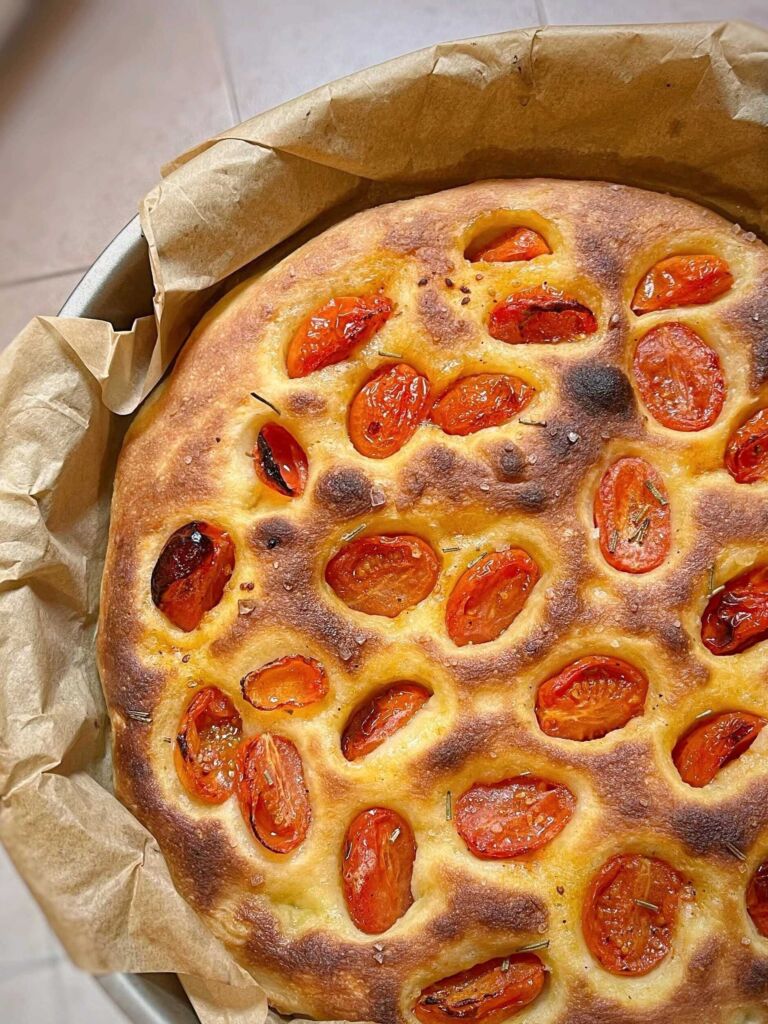
Focaccia Barese Recipe
Focaccia Barese
Course: Bread1
focaccia30
minutes25
minutes3
hoursIngredients
125g manitoba flour – *see note
125g semolina flour
75g potato – about 1 medium potato, peeled, boiled, mashed and cooled
150-170ml warm water
3g dry brewers yeast – *see note
1 Tbsp extra virgin olive oil
7g salt
- Topping
10-12 cherry tomatoes, halved
Dried oregano
Salt and freshly cracked black pepper
Directions
- Measure flours into a large bowl. Stir in the yeast.
- Add in half of the water and the potato. Stir with a wooden spoon or mix with your hands to begin incorporating the ingredients. Slowly add in remaining water until all the flour is incorporated and a homogeneous dough begins to form. Mix in the olive oil and salt. Turn out onto a lightly floured work surface. Knead the dough for 5-10 minutes until smooth. It’s ok if the dough is sticky; don’t add more flour. Dough can also be made in an electric stand mixer fitted with the dough hook.
- Transfer dough to a lightly oiled bowl and roll the dough ball over in the bowl so it is entirely coated with a shine of oil. Cover with plastic wrap. Let rest at room temperature for 2 ½ – 3 hours, or until doubled.
- Meanwhile, marinate the tomatoes. Add the cherry tomato halves to a small bowl and drizzle with olive oil. Sprinkle with dried oregano, salt, and black pepper. Stir and let sit at room temperature.
- Turn dough out into a 30cm round pan that has been brushed with olive oil. Gently press down with your fingertips to stretch the dough out. If your hands stick to the dough, dampen them with olive oil. Cover and let rest for 30 minutes.
- Meanwhile, preheat oven to 220 °C. Drizzle the top of the focaccia with olive oil and dimple the top of the dough with your fingertips. Press tomato halves in the dimples and drizzle over any juices from the marinade bowl. Sprinkle with dried oregano and salt. Bake for 20-25 minutes, or until golden brown.
Notes
- * Bread flour can be substituted in an equal amount for the manitoba flour
- * In Italy, I use Paneangeli Mastro Fornaio Lievito di Birra. Feel free to use whatever brand of instant yeast you prefer.
More Recipes







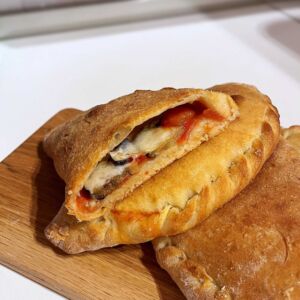

Leave a Reply
You must be logged in to post a comment.